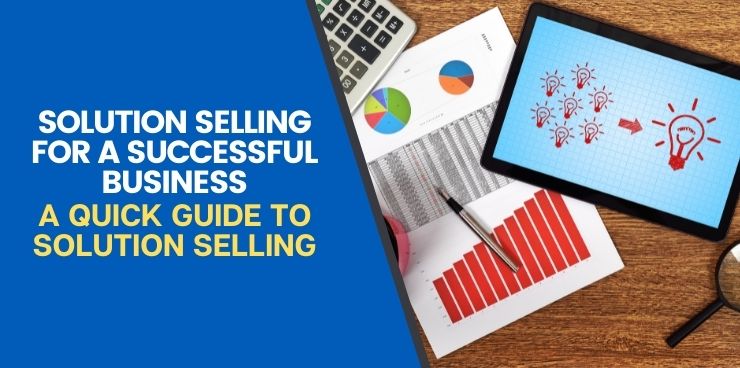Solution Selling– It’s all the buzz these days.
Whether you’ve heard it through the grapevine or you swear you’ve seen it displayed in bold somewhere in your company breakroom, Solution Selling has been an eminently effective methodology that many businesses have utilized and profited from over the years.
But perhaps you haven’t heard of it at all, and are more of a Patrick Star of sorts who lives under a rock (it happens). Many of those who are even familiar with this renowned selling concept fail at implementing it successfully, so it’s important to make sure you completely understand what solution selling is and why it’s different from just simply selling a product.
That’s why we’ve put together this simple guide to help you successfully identify, understand and implement the power of solution selling within your business so you can see your sales numbers soar.
What is Solution Selling?
Let’s travel back to the 1970s to when a man named Michael Bosworth coined the term “solution selling.” In the simplest of terms, this is when a sales rep finds customer pain points and offers their product as a solution.
With this methodology, Bosworth established a sales strategy for the sales team at Xerox when he documented and analyzed their behaviors. The solution selling methodology ended up being sold and applied by SPO and is still currently managed by them today.
So all in all, solution selling is when you identify a prospect’s problem, even when they are not aware of one, and help them find a solution to their problem by positioning yourself (or your business) as the provider that makes their lives better.
You will know that your sales reps are ready to implement solution selling when they can effectively uncover prospect pain points when the prospect hasn’t realized it themselves.
In a world where people are looking for solutions, it’s no wonder that solution-based selling has become so popular.
 What Exactly Does it Mean to Sell Solutions Rather than Products?
What Exactly Does it Mean to Sell Solutions Rather than Products?
Solution selling is about more than just the product, its specs and its features. It’s also a question of how you sell it, how to tap into your customers’ emotional needs, pain points and how to come up with the best solutions to fulfill them.
When you sell solutions, not products, you are emphasizing the “why” rather than the “what” when approaching a sale and making a genuine connection with people. The “what” is always going to be second to the “why” your customer may need it.
If you’re interested in selling solutions over products, book a call with us today at Selling Revolution. We offer customized solutions that will equip your team with the best tools and resources they need to close more sales and generate more revenue.
Pros vs. Cons
Solution selling is a game-changing sales strategy that enhances the experience for your customers. A rep doesn’t just sell products and go on their way, they’re there every step of the customer journey until they have all their problems solved from the solutions you’ve set in place.
But like with every great methodology out there in the market, there are pros and cons. Here are some examples of how solution selling can be a benefit as well as a detriment.
Pros:
- It’s buyer-friendly: When solution selling is done right, it can stimulate a more personal connection between reps and prospects that can inspire your prospects to come to their own conclusions on what they need.
- It’s an established technique: As we went over earlier, solution selling has been actively useful since the 70s. This validates that it is a credentialed process that has benefitted a diverse variety of companies across many different industries.
- It serves a global purpose: From companies big and small in any area of the world, solution selling has proven that using value proposition over certain services or features is the way to go.
Cons:
- It can be complex: Since solution selling follows a specific formula, it could result in your sales reps not being prepared when a prospect asks an “off the scrip” question. If your sales rep doesn’t have the skills to back up the sale, they could lose it in the end.
- It can come off as pushy: If your sales reps struggle with naturally connecting with your prospects, your sales reps can come off as intrusive and make your prospects uncomfortable during the sales pitch.
- It can make conversations quite stale: Solution selling’s question/answer format can be tricky for your sales reps to deliver in a natural and engaging way. If your sales reps lack in keeping the flow of a conversation, this technique might be difficult to implement.
As you can see, the pros and cons of solution-based selling depend on the experience, talent and communication skills of your sales reps. If your sales reps can’t adapt to this new methodology, you can expect that it won’t be providing the results you had hoped for.
5 Main Steps To Begin Solution Selling
Now that we’ve covered what solution selling is, how it’s not just about selling products and the pros and cons that come with it, let’s get into how to actually start the solution selling process.
Here are our five main steps in beginning the art of solution selling successfully:
1. Identify Customer Pain Points
Without knowing your customers’ pain points, you can’t effectively target prospects or present them with a solution. Luckily for us in sales, there’s no better way than to ask.
Defining customer needs starts with understanding their most common problems and why they are choosing your business to solve them.
By simply asking them questions like: “How did you decide to choose our company over others?” or “When did you realize you needed this problem solved and why?” you are immediately opening up the space for your prospects to express their needs which brings you one step closer in finding a solution that works for them.
2. Diagnose with Open-ended Questions
Speaking of questions, let’s talk about the powerful role open-ended questions play in your solution selling technique.
Once you’ve identified your prospect’s problem, you should have a developed set of questions that will bring you closer to your pain-point diagnosis. These questions should start off broad and provide you with a general background story of your prospect.
Once you get the necessary information from them, you can start asking more specific questions that stem from their previous answers– basically like follow-up questions that’ll eventually get you to the core of what solution they need from you.
3. Qualify Leads
Lead qualification is the key to every successful B2B sales pipeline. It aims at turning your new business opportunities into leads by gathering all necessary information and tailoring products accordingly for each individual, increasing the chances they will convert into paying customers when their customized goals are met.
You can effectively qualify leads by using lead scoring models, researching them through their social media accounts, enhancing your data profiles, utilizing lead forensics and more. There are plenty of great sales tools out there, so don’t be afraid to try more than one.
 4. Educate Customer with Selling Value
4. Educate Customer with Selling Value
The best way to sell anything is by focusing on what your customer will get from it.
Whether you’re a sales manager or an individual seller, make sure that the value of each product can be demonstrated clearly and persuasively so potential buyers understand why they need your particular service/product in their lives.
The best way to know if your product is a compelling investment is by considering these questions:
- How does life become easier for the prospect when they buy your product?
- How much time does your product save them compared to what they are using now?
- What are the positive long-term benefits that come with purchasing your product?
- How much money will they save when they use your product? What could they do with that extra money?
- How will the product make your prospect feel? What emotional need does it fulfill?
Having your sales reps ask these kinds of questions will reveal to your potential customers the remarkable value that you can provide them compared to your competitors, which will, in turn, accelerate your business’ revenue.
5. Present Solution and Close the Deal
As a sales professional who has been around the block a few times, it’s safe to say that know it’s inevitable that your prospects will have objections during a sale.
That is why it is imperative that you are prepared to counter their objections and outsmart them with your impressive selling finesse.
The best ways to do this are by:
- Reviewing past sales opportunities from similar prospects that weren’t successful.
- Preparing a list of maybe 10-20 of the most common objections.
- Writing up a script or jot down notes to follow and reference in the event an objection occurs.
When in doubt, get prepared! You don’t want to find yourself in a situation where you are at a loss for words and your prospect decides to find a solution elsewhere.
Wrapping Up
I hope after reading this article, you have a better understanding of what solution selling is and how it could make a difference in your business’ sales results.
We understand how complex and overwhelming the sales process can be, but you don’t have to go at it alone.
At Selling Revolution, we take pride in offering decades of knowledge and experience to help guide you in developing and implementing a solution selling process that produces the best results for your unique business.
Book a call with us to start your revolution today!


 What Exactly Does it Mean to Sell Solutions Rather than Products?
What Exactly Does it Mean to Sell Solutions Rather than Products?
 4. Educate Customer with Selling Value
4. Educate Customer with Selling Value